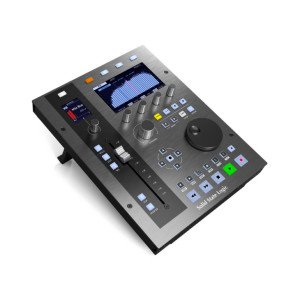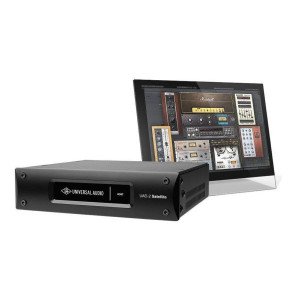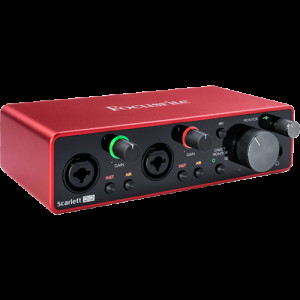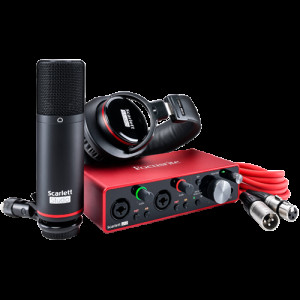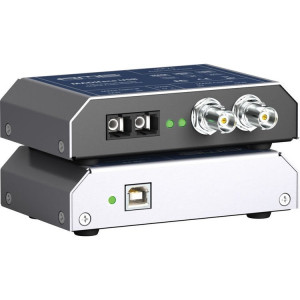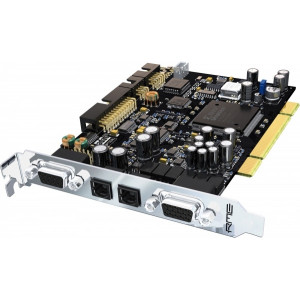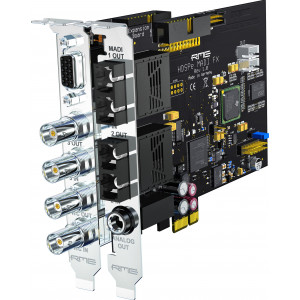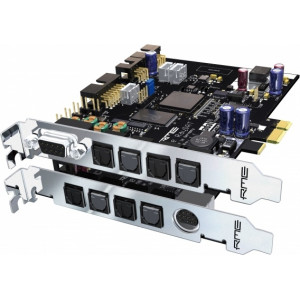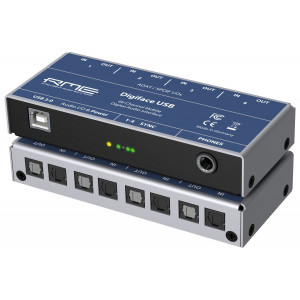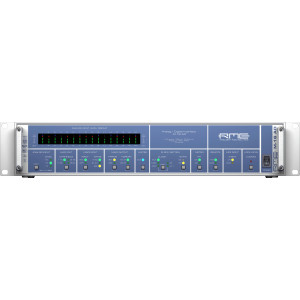Аудио интерфейс RME Fireface UFX+, thunderbolt & USB 3

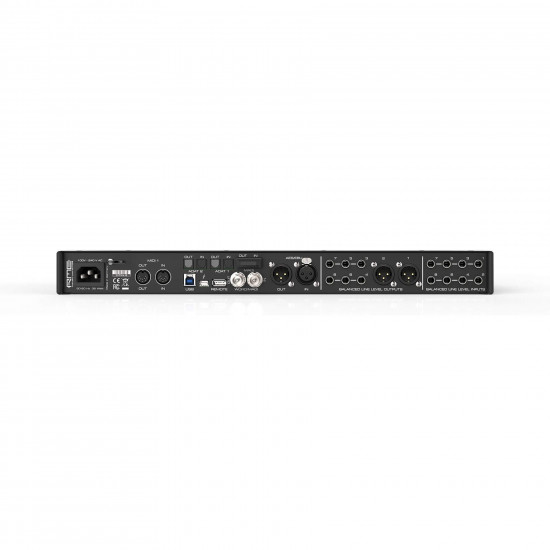
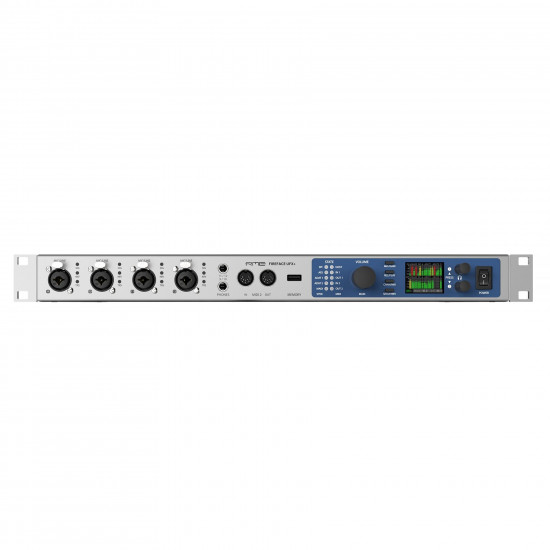



- Наличност: Извън наличност
- Кат. номер: 12063
|
|

|

Купи на изплащане със стоков кредит от Банка ДСК
• Улеснена процедура за електронно подписване
• Атрактивни условия по кредита
• Параметри изцяло по Ваш избор
• Одобрение до няколко минути изцяло онлайн
Comprehensive MADI Connectivity
The Fireface UFX+ opens the doors to a host of RME and 3rd party digital and analog I/O solutions. Expanding your analog channel count, the ability to route/mix within the digital domain through numerous sources presents many flexible options. Multiple external MADI devices can also be connected in series.To further enhance MADI flexibility, the Fireface UFX+ boasts some typical RME-style features. For example in USB 2 mode, which is limited to 30 channels I/O (12 analog plus 16 ADAT plus AES), the MADI I/O is still available via RME’s integrated hardware mixer TotalMix FX. Word Clock I/O (BNC) can be switched to MADI I/O (coaxial), and a special split mode even supports the use of both MADI I/Os simultaneously, with 32 channel each on optical and coaxial.
Improved DURec (Direct USB Recording)
DURec, which is available on the front of the Fireface UFX+, now offers second generation hardware with improved USB functionality and compatibility, providing greater reliability even with slower or multi-partitioned USB thumb drives.
The maximum number of recordable channels has been raised to 76, meaning all 12 analog inputs plus 64 MADI channels can be recorded simultaneously. An internal Realtime Clock (RTC) delivers time-stamped files, and playback now includes several advanced player functions previously unavailable.
TotalMix FX
Since 2001, TotalMix has added unlimited routing and mixing to RME audio interfaces. Its unique capability to create as many independent submixes as output channels available, turned it into the most flexible and powerful mixer of its kind.
With supported hardware, TotalMix FX includes a complete effects system, which not only adds flexibility to the recording chain, but also makes latency saddled software solutions obsolete.
TotalMix FX can completely replace an external mixer, enabling the creation of multiple latency-free monitor mixes with EQ, Dynamics, Reverb and Delay for any outputs, incl. main monitors and headphone mixes for musicians.
TotalMix FX for iPad™ App
TotalMix FX for iPad™ adds full control over hardware mixer and DSP effects for Fireface UFX+, UFX, UCX, 802, Babyface, Babyface Pro and MADIface Pro when in Class Compliant Mode, and lets you create, store and load complete mixes directly from the iPad™
Technical Specifications
Analog
AD, Line In 1-8, rear• Resolution AD: 24 bit
• Signal to Noise ratio (SNR): 113 dB RMS unweighted, 116 dBA
• Frequency response @ 44.1 kHz, -0.1 dB: 5 Hz – 20.8 kHz
• Frequency response @ 96 kHz, -0.5 dB: 3 Hz – 45.8 kHz
• Frequency response @ 192 kHz, -1 dB: 2 Hz – 92 kHz
• THD: < -110 dB, < 0.00032 %
• THD+N: < -104 dB, < 0.00063 %
• Channel separation: > 110 dB
• Maximum input level: +19 dBu
• Input: 6.3 mm TRS jack, electronically balanced
• Input impedance: 8 kOhm unbalanced, 12 kOhm balanced
• Input sensitivity switchable to Lo Gain, +4 dBu
• Input level for 0 dBFS @ Lo Gain: +19 dBu
• Input level for 0 dBFS @ +4 dBu: +13 dBu
• Variable gain: 0 to +12 dB
• Minimum level for 0 dBFS: +1 dBu, -1.2 dBV
Microphone In 9-12, front
As AD, but:
• Input: XLR, electronically balanced
• Input impedance: 3.4 kOhm
• Signal to Noise ratio (SNR): 115 dB RMS unweighted, 118 dBA
• Gain range: 75 dB
• Maximum input level, Gain 0 dB: +18 dBu
• Maximum input level, Gain 75 dB: -57 dBu
• CLIP LED: 0 dBFS • SIG LED: -60 dBFS
Instrument In 9-12, front
As AD, but:
• Input: 6.3 mm TS jack, unbalanced
• Input impedance: 1 MOhm
• Signal to Noise ratio (SNR): 114 dB RMS unweighted, 118 dBA
• Gain range: 42 dB
• Maximum input level, Gain 8 dB: +21 dBu
• Maximum input level, Gain 50 dB: -21 dBu
DA, Line Out 3-8, rear
• Resolution: 24 bit
• Dynamic range (DR): 115 dB RMS unweighted, 118 dBA
• Frequency response @ 44.1 kHz, -0.5 dB: 5 Hz – 20.8 kHz
• Frequency response @ 96 kHz, -0.5 dB: 5 Hz – 45 kHz
• Frequency response @ 192 kHz, -1 dB: 5 Hz - 89 kHz
• THD: < -110 dB, < 0.00032 %
• THD+N: < -104 dB, < 0.00063 %
• Channel separation: > 110 dB
• Maximum output level: +19 dBu
• Output: 6.3 mm TRS jack, servo-balanced
• Output impedance: 75 Ohm unbalanced, 150 Ohm balanced
• Output level switchable Hi Gain, +4 dBu, -10 dBV
• Output level at 0 dBFS @ Hi Gain: +19 dBu
• Output level at 0 dBFS @ +4 dBu: +13 dBu
• Output level at 0 dBFS @ -10 dBV: +2 dBV
DA - Stereo Monitor Output XLR (1-2)
As DA, but:
• Output: XLR, balanced
• Output level switchable 24 dBu, Hi Gain, +4 dBu, -10 dBV
• Output level at 0 dBFS @ 24 dBu: +24 dBu
• Output level at 0 dBFS @ Hi Gain: +19 dBu
• Output level at 0 dBFS @ +4 dBu: +13 dBu
• Output level at 0 dBFS @ -10 dBV: +2 dBV
DA - Stereo Monitor Output Phones (9-12)
As DA, but:
• Output: 2 x 6.3 mm TRS stereo jack, unbalanced
• Maximum output level at 0 dBFS, High: +19 dBu
• Maximum output level at 0 dBFS, Low: +2 dBV
• Output impedance: 2 Ohm
• Max power per channel @ 32 Ohm load, 0.1% THD: 210 mW (2.6 Vrms, +10.5 dBu)
MIDI
• 2 x MIDI I/O via 5-pin DIN jacks
• Galvanically isolated by optocoupled input
• Hi-speed mode: Jitter and response time typically below 1 ms
• Separate 128 byte FIFOs for input and output
• 1 x MIDI I/O via MADI
• Invisible transmission via User bit of channel 56 (up to 48 kHz)
• Invisible transmission via User bit of channel 28 (up to 96 kHz)
Digital
• Clocks: Internal, ADAT, AES, MADI, word clock
• Low Jitter Design: < 1 ns in PLL mode, all inputs
• Internal clock: 800 ps Jitter, Random Spread Spectrum
• Jitter suppression of external clocks: > 30 dB (2.4 kHz)
• Effective clock jitter influence on AD and DA conversion: near zero
• PLL ensures zero dropout, even at more than 100 ns jitter
• Digital Bitclock PLL for trouble-free varispeed ADAT operation
• Supported sample rates: 28 kHz up to 200 kHz
Digital Inputs
MADI
• Optical via FDDI duplex SC connector
• 62.5/125 and 50/125 compatible
• Coaxial via BNC (Word Clock input), 75 Ohm
• High-sensitivity input stage (< 0.2 Vpp) • Accepts 56 channel and 64 channel mode, plus 96k Frame
• Standard: up to 64 channels 24 bit 48 kHz
• S/MUX: up to 32 channels 24 bit 96 kHz
• S/MUX4: up to 16 channels 24 bit 192 kHz
• Lock range: 25 kHz – 54 kHz
• Jitter when synced to input signal: < 1 ns
AES/EBU
• 1 x XLR, transformer-balanced, galvanically isolated, according to AES3-1992
• High-sensitivity input stage (< 0.3 Vpp) • SPDIF compatible (IEC 60958)
• Accepts Consumer and Professional format
• Lock range: 27 kHz – 200 kHz
• Jitter when synced to input signal: < 1 ns
• Jitter suppression: > 30 dB (2.4 kHz)
ADAT Optical
• 2 x TOSLINK, format according to Alesis specification
• Standard: 2 x 8 channels 24 bit, up to 48 kHz
• Double Speed (S/MUX): 2 x 4 channels 24 bit 96 kHz
• Quad Speed (S/MUX4): 2 x 2 channels 24 bit 192 kHz
• Bitclock PLL ensures perfect synchronisation even in varispeed operation
• Lock range: 31.5 kHz – 50 kHz • Jitter when synced to input signal: < 1
SPDIF optical (ADAT2)
• 1 x optical, according to IEC 60958
• Accepts Consumer and Professional format
• Lock range: 27 kHz – 200 kHz
• Jitter when synced to input signal: < 1 ns
• Jitter suppression: > 30 dB (2.4 kHz)
Word Clock
• BNC
• Internal termination 75 Ohm switchable
• Automatic Double/Quad Speed detection and internal conversion to Single Speed
• SteadyClock guarantees super low jitter synchronization even in varispeed operation
• Not affected by DC-offsets within the network
• Signal Adaptation Circuit: signal refresh through auto-center and hysteresis
• Overvoltage protection
• Level range: 1.0 Vpp – 5.6 Vpp
• Lock Range: 27 kHz – 200 kHz
• Jitter when synced to input signal: < 1 ns
• Jitter suppression: > 30 dB (2.4 kHz)
Digital Outputs
MADI
• Optical via FDDI duplex SC connector
• 62.5/125 and 50/125 compatible
• Cable length: up to 2000 m
• Coaxial via BNC, 75 Ohm
• Output voltage 600 mVpp
• Cable length: up to 100 m
• Generates 56 channel and 64 channel mode, plus 96k Frame
• Standard: up to 64 channels 24 bit 48 kHz
• S/MUX / 96k Frame: up to 32 channels 24 bit 96 kHz
• S/MUX4: up to 16 channels 24 bit 192 kHz
AES/EBU
• XLR, transformer-balanced, galvanically isolated, according to AES3-1992
• Output level Professional 4.5 Vpp, Consumer 2.6 Vpp
• Format Professional according to AES3-1992 Amendment 4
• Format Consumer (SPDIF) according to IEC 60958
• Single Wire mode, sample rate 28 kHz up to 200 kHz
ADAT
• 2 x TOSLINK
• Standard: 2 x 8 channels 24 bit, up to 48 kHz
• Double Speed (S/MUX): 2 x 4 channels 24 bit 96 kHz
• Quad Speed (S/MUX4): 2 x 2 channels 24 bit 192 kHz
SPDIF optical (ADAT2)
• Format Consumer (SPDIF) according to IEC 60958
• Sample rate 28 kHz up to 200 kHz
Word Clock
• BNC
• Max. output voltage: 5 Vpp
• Output voltage @ 75 Ohm termination: 4.0 Vpp
• Output impedance: 10 Ohm
• Frequency range: 27 kHz – 200 kHz
General
• Power supply: Internal switching PSU, 100 - 240 V AC, 36 Watts
• Idle power consumption: 19 Watts
• Typical power consumption: 22-25 Watts
• Dimensions including rack ears (WxHxD): 483 x 44 x 210 mm (19" x 1.73" x 8.5")
• Dimensions without rack ears (WxHxD): 440 x 44 x 210 mm (17.3" x 1.73" x 8.3")
• Total depth: 240 mm (9.4”)
• Weight: 3 kg ( 6.6 lbs)
• Temperature range: +5° up to +50° Celsius (41° F up to 122°F)
• Relative humidity: < 75%, non condensing
Notes on USB 3.0 Operation
The special features and possible problems of using USB 3 are described in more detail in the manual.
Current Compatibility Information:
- Fully compatible to Intel's USB 3 implementation, which - on current Windows and Mac computers - is part of the chipset. USB 3 sockets that are connected via an internal cable (not directly soldered onto the motherboard) can cause transmission errors. These are shown in the Settings dialog.
- Fully compatible to AMD's USB 3 implementation. USB 3 sockets that are connected via an internal cable (not directly soldered onto the motherboard) can cause transmission errors. These are shown in the Settings dialog.
- Fully compatible to Fresco USB 3. This rarely used chip can be found for example on the Sonnet Tango 3.0 PCIe card.
- Compatible to NEC / Renesas USB 3. Real-world performance and error-free operation depend on the firmware version, driver version and the PCB layout of the respective extension card/motherboard.
- ASMedia - not compatible.
- Etron EJ168A - not compatible.
- Texas TUSB7340 - not compatible.
- Via VL800/805 - not compatible.
Още
Линк към сайта на производителя
Документи и драйвери
В кутията
- RME Fireface UFX+ USB 3.0 and Thunderbolt Audio Interface
- AC Power Cable
- 6' USB 3.0 Cable
- RME Driver CD


